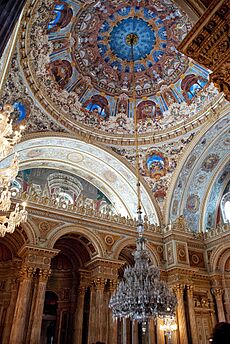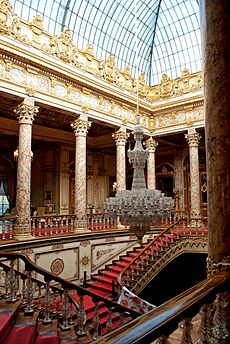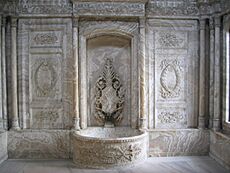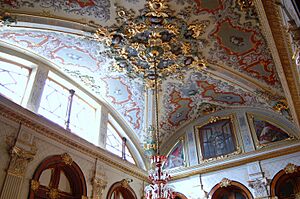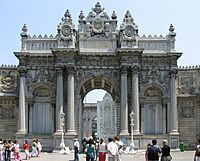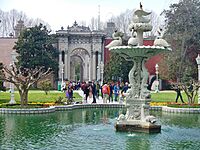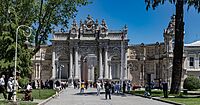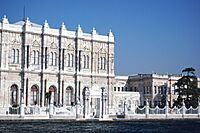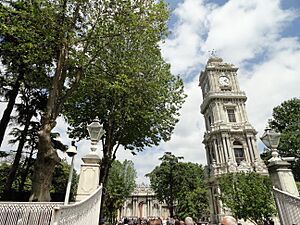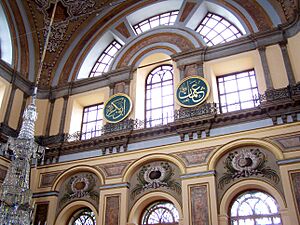Dolmabahçe Palace facts for kids
Quick facts for kids Dolmabahçe Palace |
|
|---|---|
|
Dolmabahçe Sarayı
|
|

A view of Dolmabahçe Palace from the Bosporus
|
|
| General information | |
| Type | Palace (1856–1984) |
| Architectural style | Baroque Revival and Rococo Revival |
| Location | Istanbul, Turkey |
| Coordinates | 41°02′22″N 29°00′06″E / 41.03944°N 29.00167°E |
| Construction started | 1843 |
| Completed | 1856 |
| Client | Ottoman sultans |
| Owner | Government of Turkey |
| Design and construction | |
| Architect | Garabet Balyan |
Dolmabahçe Palace (Turkish: Dolmabahçe Sarayı) is a beautiful palace in Istanbul, Turkey. It was built in the 1800s. This grand palace sits on the European side of the Bosporus strait. For many years, it was the main place where the Ottoman Empire was run. It served as the center of power from 1856 to 1887, and again from 1909 to 1922.
Contents
History of the Palace
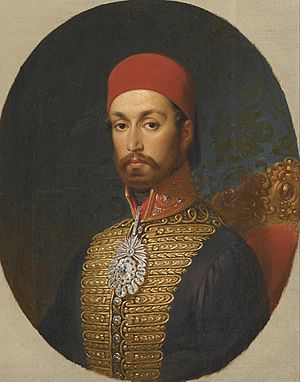
Dolmabahçe Palace was ordered by Sultan Abdülmecid I. He was the 31st sultan of the Ottoman Empire. The palace was built between 1843 and 1856. Before this, the sultan and his family lived in Topkapı Palace.
However, Topkapı Palace was quite old-fashioned. It didn't have the modern style or comfort that European palaces had. So, Sultan Abdülmecid decided to build a brand new, modern palace. It was built near where an older palace, the Beşiktaş Sahil Palace, used to be.
Hacı Said Ağa was in charge of the building work. The main architects were Garabet Balyan, his son Nigoğayos Balyan, and Evanis Kalfa. They were all part of the Balyan family, a famous family of architects for the Ottoman court.
Building the palace was very expensive. It cost a huge amount of money, equal to about 35 tonnes of gold. This was about a quarter of the government's yearly income at the time. The cost was so high that it caused big money problems for the Ottoman Empire.
The palace was home to six different sultans. They lived there from 1856 until 1924, when the Ottoman Empire ended. The last royal person to live in the palace was Sultan Abdülmecid II.
After the new Turkish Republic was formed, the palace became part of the country's national heritage. Mustafa Kemal Atatürk, who founded Turkey and was its first President, used the palace as his summer home. He made many important decisions there. Atatürk also spent his last days in this palace. He passed away there on November 10, 1938.
Today, the palace is looked after by the Directorate of National Palaces. This group is part of the Grand National Assembly of Turkey.
Where the Palace Is
The area where Dolmabahçe Palace stands was once a bay on the Bosporus. This bay was used as a place for the Ottoman navy to anchor their ships. Over time, in the 1700s, the bay was filled in. It became a beautiful imperial garden that the Ottoman sultans loved.
The name Dolmabahçe comes from this history. Dolma means "filled in" and bahçe means "garden" in Persian. So, it means "filled-in garden."
Before the current palace, several smaller summer palaces and wooden buildings were here. These made up the Beşiktaş Waterfront Palace complex. The palace grounds cover a large area of 110,000 square meters. The Bosporus is on one side, and a steep hill is on the other.
Palace Design and Layout
Dolmabahçe is the biggest palace in Turkey. It covers about 45,000 square meters. Inside, it has 285 rooms, 46 halls, six hammams (Turkish baths), and 68 toilets.
The palace's design mixes different styles. You can see parts of Baroque, Rococo, and Neoclassical styles. These are blended with traditional Ottoman architecture. This mix created a new and unique look. The palace's design shows how European styles became more popular in Ottoman art and culture during the time of change called the Tanzimat.
The outside of the palace, especially from the Bosporus, looks like a classic European palace. It has two main wings with a large central section.
However, the inside of the palace still keeps many traditional Ottoman features. It is divided into two main parts. The southern part is called the Mabeyn-i Hümâyûn, or selamlık. This was the public area for men, where the sultan met with officials and visitors.
The northern part is the Harem-i Hümâyûn, or the Ottoman Imperial Harem. This was the private living area for the sultan and his family. A huge Ceremonial Hall (Muayede Salonu) separates these two areas. This hall is 2,000 square meters and has a dome that is 36 meters high.
Because the harem needed to be very private, the main entrance for visitors is on the narrow southern side. The harem area has eight connected apartments. Each apartment has a bathroom. These were for the sultan's wives, favorites, and his mother, the Valide sultan.
Decor and Furnishings
Unlike Topkapı Palace, which is known for its tiles, Dolmabahçe is covered in gold and crystal. About 14 tonnes of gold were used to decorate the ceilings. Over 100 kilograms of gold were used in total.
The Ceremonial Hall has the world's largest crystal chandelier. It has 750 lamps and weighs 4.5 tonnes. For a long time, people thought this chandelier was a gift from Queen Victoria. But in 2006, a receipt was found showing the sultan paid for it himself.
Dolmabahçe Palace has the largest collection of Bohemian and Baccarat crystal chandeliers in the world. The famous Crystal Staircase is shaped like a double horseshoe. It is made of Baccarat crystal, brass, and mahogany wood.
Expensive stones were used for decoration. These include marble from Marmara Island, Egyptian alabaster, and porphyry from Pergamon.
The palace also has many beautiful Hereke palace carpets. These were made by the Hereke Imperial Factory. The carpet in the main hall is the largest Hereke rug in the world. There are also 150-year-old bearskin rugs. These were given to the sultan as a gift by Tsar Nicholas I.
A collection of 202 oil paintings is displayed in the palace. A special part of this collection includes 23 paintings by Ivan Aivazovsky. He was a court painter and created these during his visits to Istanbul. The collection also has paintings by famous European artists like Gustave Boulanger and Jean-Léon Gérôme. There are also paintings by Turkish artists such as Osman Hamdi Bey.
From the very beginning, the palace had the most advanced technology. Gas lighting and modern water-closets were brought from Great Britain. At that time, many other palaces in Europe did not have these features. Later, electricity, a central heating system, and an elevator were also added.
Important Rooms
Medhal (Main Entrance) Hall

Your visit to Dolmabahçe Palace starts in the Medhal Hall. Rooms leading off this hall face either the sea or the land. The rooms facing the sea were used by important officials, like the grand vizier and other government ministers. The rooms facing the land were used by palace administrators.
Guests would wait in this hall. Then, a palace officer would lead them inside at the right time. In the Medhal, you can see special Boulle tables. They have the tughra (royal signature) of Sultan Abdülmecid on them. The sultan's royal symbol is also on the fireplace. A large English chandelier with sixty arms hangs in the middle of the room. The furniture and curtains are made of Hereke fabrics in a royal red color.
The Clerk's Hall
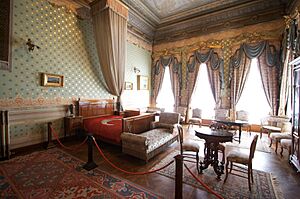
The second room to the right after the Medhal is the Clerk's Hall. It is also called the Tiled Room. The largest painting in the palace is here. It shows the Surre Procession by Stefano Ussi. The Surre was a caravan that traveled from Istanbul to Mecca. It carried money to help maintain the Kaaba and support the people of Hejaz.
On the right wall, there is a painting by Rudolf Ernst showing a fire at the Paris Municipal Theater. There is also a painting of a Dutch Village Girl by Delandre. This room has French-style furniture and valuable porcelain vases.
Atatürk's Room
Mustafa Kemal Atatürk spent his final days in the palace as his health got worse. He passed away at 9:05 A.M. on November 10, 1938. This happened in a bedroom located in the former harem area of the palace. After his death, all the clocks in the palace were stopped and set to 9:05. Today, the clocks outside his room show the actual time in Turkey. However, the clock in the room where he died still points to 9:05.
Harem Section
The harem was a traditional part of many Middle Eastern buildings. Sultan Abdülmecid built the harem to create separate living areas for the royal family. It was common for the sultan's concubines to live in the harem. This section also included rooms for the sultan's children to live and learn, as well as the sultan's own living quarters.
In the past, sultans kept their wives and concubines mostly within the harem. But Sultan Abdülmecid did something new. He allowed them to leave the palace to visit shops and markets, but always with supervision.
Palace Gates
Gate of the Sultan
Gate of the Treasury
Gate to the Bosporus
-
Outside view of the Gate to the Bosporus.
-
Another outside view of the Gate to the Bosporus.
-
Inside view of the Gate to the Bosporus.
Buildings Nearby
Several other buildings are located near the palace. These include the palace for the Crown Prince and living areas for palace staff and guards. There were also imperial kitchens, stables, a birdhouse, a plant nursery, and a flour mill. Other buildings included a greenhouse, a workshop for Hereke carpets, a glass factory, and a pharmacy.
A beautiful mosque in the Baroque style was built near the palace. It was designed by Garabet Balyan and built between 1853 and 1855. The queen mother, Bezm-i Âlem Valide Sultan, ordered its construction. For a while, the building was a Naval Museum. But in 1967, it became a mosque again for people to worship.
A clock tower was built in front of the Imperial Gate, next to the mosque. Sultan Abdülhamid II ordered this tower. It was designed by Sarkis Balyan and built between 1890 and 1895. The clock inside was made by a French company.
See also
 In Spanish: Palacio de Dolmabahçe para niños
In Spanish: Palacio de Dolmabahçe para niños
- List of Baroque residences
More to Read
- İskender Pala. The Jewel on the Bosphorus; Dolmabahçe Palace. TBMM Milli Saraylar Yayınları, Istanbul, 2006.
- İhsan Yücel, Sema Öner, F. Yaşar Yılmaz, Cengiz Göncü, Hakan Gülsün. Dolmabahçe Palace. TBMM Milli Saraylar Yayınları, Istanbul, 2005.
- İpek Fitöz. European Lights In Dolmabahçe Palace. TBMM Milli Saraylar Yayınları, Istanbul, 2007.



